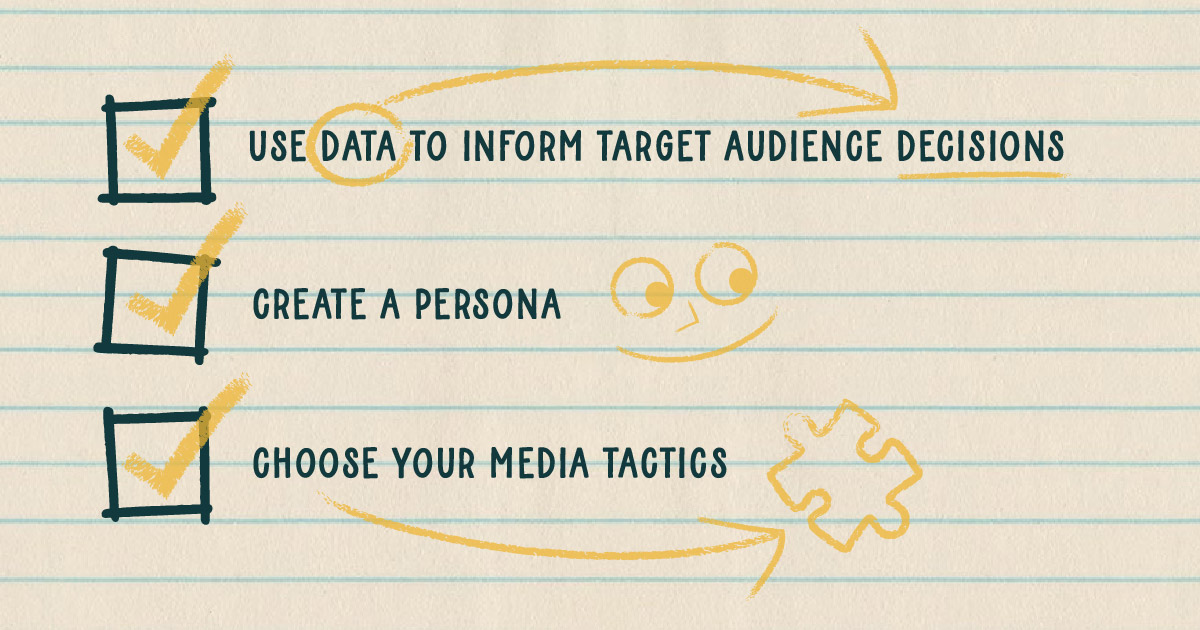12.14.23 | 4 min
Three Steps of a Target-Centric Media Strategy
Sophie Campbell
As marketing and advertising continually evolve, so should your toolbox of media tactics. SEO, Social Media, Programmatic Display Ads, OTT/CTV, and Streaming Audio are several possibilities to implement when it comes to media strategy. But how do you know where to start? Lots of questions begin to swirl…
“Should we be doing email marketing?”
“We’ve always run radio spots. Should we switch to Spotify?”
“People are on TikTok. Should we be on TikTok?”
Engaging with every digital and traditional media tactic can feel overwhelming, and it’s not necessary. One critical detail is important: remember your target audience, because the target audience always informs the media strategy.
When media strategy is informed by robust target audience research, the media tactics will come naturally. Follow along as we uncover the three essential steps to an audience-centered media strategy, and you’ll be ready to hit the ground running.
What does it mean to be audience-centered?
First things first, let’s define “audience-centered.”
When it comes to advertising, you must always keep the target audience top of mind, no matter what media strategy you implement. You may ask yourself, “Is a target-centric media strategy different from what I’m already doing?” Let’s find out.
A target-centric messaging approach reaches your audience where they are and when they need it. You can achieve this by tailoring your messages and content to the targets’ unique needs.
Broadcasting messaging widely and hoping to catch some of your intended audience is less effective. To create an audience-focused media strategy that effectively achieves your client’s marketing objectives and reaches the target audience, in-depth research is required to determine placement and tailor messaging.

Step 1. Use Data to Inform Target Audience Decisions
“We are data-informed, not data-driven.” – Edward Moore, CEO, 116 & West
Edward says it beautifully: not all decisions need to be driven by data, and determining your target audience is often more nuanced. Combining relevant, accurate data with human insights results in a data-informed decision instead. More about the difference between the two is below:
Data-Informed – Describes the application and interpretation before decision-making. Data informs us, but it is not the only driver. The data is considered, but a human ultimately makes the decision, leveraging both quantitative and qualitative data. Source: Northwestern
Data-Driven – Describes data used to make or help make a decision. This approach ultimately means that the data drives decision-making. Source: Northwestern
To better understand your target audience’s motives, using a research tool such as MRI Simmons can help uncover consumer habits and inform decisions. The data below on current media habits across age groups will help us develop a target-centric media strategy.
- 78.86% of 18-24 year olds viewed cable TV channels in the last 7 days.
- 69.65% of 25-34-year-olds have a streaming audio subscription.
- People ages 35-44 are 38% more likely to purchase print magazines or visit a magazine’s website.
- 25.51% of 45-54-year-olds have a household subscription to SMX Radio.
- 92.63% of 55-64-year-olds have viewed TV channels or networks in the last 7 days.
- People ages 65+ are 62% more likely to have cable or satellite TV.
*This data used responses from the Summer 2023 MRI-Simmons USA study, population (000). Start field date: 5/6/2022. End field date: 7/31/2023.
Step 2. Create a Persona
Now it’s time for the fun part: personas. Creating fictional characters to represent the target audiences selected during our data-informed process will help them come to life. Who are they? What do they like to do? A name, a list of hobbies, and developing a personality will assist in determining their motives and, therefore, which strategies will best reach each audience.
Step 3. Choose Your Media Tactics
Now that your target audience is well-defined, it’s time to choose tactics that will reach your audience at the right time. With the rise of digital media, placement options are abundant, and media tactics are categorized as traditional or digital; both are used to communicate unique messaging to the target audience.
Traditional tactics include Broadcast TV, Radio, Print, Out of Home (OOH), and Direct Mail. Digital media tactics include running campaigns with OTT/Connected TV, Streaming radio, SEM, Programmatic display, and emerging platforms. Once again, a data-informed approach is best when selecting your media tactic, traditional or otherwise.
Other important factors include the target audience’s geographic location, the campaign budget, and the variety of creative assets. With some TV viewership moving more towards streaming ads on platforms like Hulu and Netflix, it is necessary to have an integrated approach, implementing both traditional and digital tactics.
As of September 2023, Nielsen reports that only 46% of U.S. homes access programming through a traditional cable or satellite service. Compared to September 2021, that’s a 23.6% decrease. With the decline in cable viewership, television is not as viable as a stand-alone strategy. Our clients successfully use TV ads as an integrated strategy with tactics like OTT and streaming audio. Kendall Auto Group, for instance, appreciates the appointment-based aspect of TV – knowing that people are attentive, not skipping commercials, while watching live sports and chandelier (special events or highly-rated) programming.
When it comes to media planning, choose the tactics that best suit your audience and their media habits – there is no one-size-fits-all regarding media tactics. Each client deserves a media strategy focused on their unique target and catered to their needs.
So, your media strategy is set. Now what? Learn how to Create Ad Copy that Sells.

